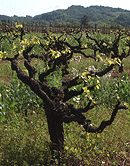|
Wineries
Wines
More Info. |

About
Wine Labels Much of the
information found on wine labels is required by law
in California. Other information (i.e. "Old Vines")
is provided by the producer to further describe the
wine. Information found on most labels
includes: Brand
(Producer) The brand name is used by the
bottler to identify the product. The brand name is
of utmost importance since many wines are purchased
based solely on the producer's reputation. Any
brand name is acceptable so long that it does not
mislead the consumer. Vintage
Date A vintage date on the label
indicates that 95% or more of the wine is
produced from grapes grown in that year. If no date
is present then the wine is most likely a blend
from grapes grown in different years. Varietal
Designations The names of the dominant
grapes used in the wine. A varietal designation on
the label means that at least 75% of that
grape variety is used in the wine. Cabernet
Sauvignon, Merlot, Pinot Noir and Chardonnay are
examples of grape varieties. Wines that do not have the
75% of a single grape variety often have
proprietary names or may be designated such as "Red
Table Wine." Appellation of
Origin The place in which the
dominant grapes used in the wine are grown. A
country, state, county, region, appellation or
vineyard on the label means that at least
75% of the wine is produced from grapes
grown in the place named. Examples include
California, North Coast, Sonoma County and Santa
Maria Valley. American Viticultural Area
(AVA) An American Viticultural Area
(AVA) is an officially recognized well-defined
grape-growing region with soil, climate, and
geographic features which set it apart from the
surrounding areas. An AVA designation on the label
indicates that 85% or more of the wine is
produced from grapes grown in the particular AVA.
Carneros, North Coast, Stag's Leap District and Dry
Creek Valley are examples. Estate
Bottled "Estate Bottled" means that
100% of the wine came from grapes grown on
land owned or controlled by the winery, located in
the viticultural area. The winery then crushes and
ferments the grapes, finishes, ages, processes and
bottles the wine in one continuous operation. This
is sometimes indicated as "grown, produced and
bottled by." In the case where the winery
and the winery's own vineyards are not in the same
viticultural area, the winery may designate that
the wine has been "Proprietor Grown." Produced and Bottled
by This indicates that the
winery crushed, fermented and bottled a minimum of
75% of the wine in this bottle. It does not
mean that the winery grew the grapes used in the
wine. Made and Bottled
by This indicates that a minimum
of 10% of the wine was fermented at the
winery. In general, this may infer a lesser quality
wine than "estate bottled" or "produced and bottled
by" designations. Vinted and Bottled
by Usually the same as "made and
bottled by." Alcohol
Content This is the percentage of
alcohol by volume of the wine. By U.S. law, wines
may have a minimum of 7 percent to a maximum of 14
percent alcohol and must be within 1.5 percent of
the actual alcohol content (but within the stated
limits). Ports have a legal range of 18 to 20
percent and Sherries have a 17 to 20 percent
range. Unfiltered/Unfined The common practice of
filtering or fining wines to remove sediment can
sometimes remove some of the wine's flavor or body.
A winemaker that chooses to bottle a wine without
filtering or fining will usually label it as such.
It is not uncommon to find a small amount of
harmless sediment in these bottles. Reserve Since the term "reserve" has no legal meaning in
the U.S., wineries may use this term to designate a
special bottling (i.e. "Show Reserve") or limited
production. In some cases a winery will use the
term as a marketing tool and has no other
meaning. |
||||||||||||||||||||||||||||||||||||||||||||||||
